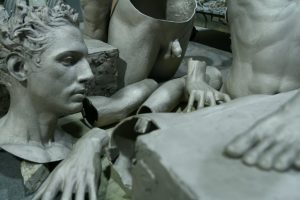

The Fighter Pilot and the Monk

Someone on the Barbara Brennan Healer’s Listserve to which I belong posted a notice about two evenings of free talks given by John Foley, a former Blue Angel pilot, and Geshe Michael Roach, the author of The Diamond Cutter. The talks concerned “Fearless success in business and life.” Well, I’m a fan of fearlessness and also of success, and my husband Sabin calls himself a Buddhist, so I registered us for the lectures.
And what a treat! I came away, as everyone in the audience seemed to, inspired and encouraged, challenged and impressed. I came away thinking. I came away witnessing my life and my actions in a new way.
Foley was a Navy pilot, and my dad was a submarine sailor in the Navy. Despite the air/sea rivalry, I was predisposed to like Foley. Moreover, I saw the Blue Angels as a kid in Tennessee. I can still remember watching them zoom so close to each other during loop-de-loops that my pounding heart wanted to fly up out of my chest. The Blue Angels elicit awe and amazement. Those planes perform some maneuvers at a distance of only 18 inches, Foley told us. Can you imagine piloting a top-of-the-line precision aircraft weighing 22 tons, while another 22 ton craft rides your belly, and then you flip upside down so the other plane is on top, while maintaining that mere foot and a half of separation?
Intriguingly, Foley didn’t call the maneuvers dangerous. He said they were just inherently unforgiving. What a fascinating perspective!
Most impressively, Foley, who attended Stanford Business school, had thought about what the Blue Angels taught him about high performance. About getting the most out of yourself so you climb up the high performance zone, that wondrous area between where you are and where you want to be. He has a system that’s smart and useful. I’ve been thinking about his 4 steps all day. I’ve been saying, “Glad to be here!” and meaning it.
Geshe Michael Roach was the first American to make it all the way through the 20 year training within Tibetan Buddhism and become a lama. He’s a medium sized guy with a scraggly fringe of hair that reaches almost to his shoulders, he wears the ocher robes of a monk, and his face radiates kindness and intelligence. When he took the stage, everyone leaned forward with an indrawn breath. This is no slight on Foley, who is a dynamic–utterly riveting–speaker. It’s just that Geshela (as they called him with affection) has this aura…
More than a decade ago Geshela’s lama told him to get a business job, and Geshala dawdled for a year or two, delaying carrying out his teacher’s command because he didn’t want to be a businessman. Finally he surrendered. He joined a tiny, fledgling company that was just starting out with a $50,000 loan. Geshela wasn’t supposed to let anyone know he was a monk, but he was supposed to apply the Buddhist principles he’d learned at the monastery. He did so. Not too long ago, the company was making over a hundred million dollars a year in sales, and then Warren Buffet bought it. For a quarter billion dollars.
Geshela’s point was that the Buddhist system works, and he’s proved it. He wants to share it with people so they stop being so anxious about the economy.
So what is this system? Essentially, it comes down to the seeds you plant in your mind with your own actions and thoughts. The mind is always recording everything you do, say, or think. So what you do, say, and think creates your present and future. Specifically, you give money away, knowing that to do so creates money and that every living person is benefitted. Thus a seed for prosperity is planted in your mind. The seed takes a little time, as seeds do, but then it sprouts into a financial opportunity.
We could call it karma, but Geshela says he’s not allowed to say that word in a business setting…
He began his talk with a discussion of emptiness and projection, though he says he’s supposed to call it ‘potential’ and not emptiness or the void.
It made me muse about how much I project onto the world, and what kind of seeds I want to plant in my mind.
Foley also supports charities and “giving forward.”
Geshe Michael Roach mentioned a charity called Three Cups of Tea, which builds schools for girls in Pakistan and Afghanistan. I am intrigued. Peace through education: what a beautiful, important seed to plant, not just in my mind, but in the world at large.



